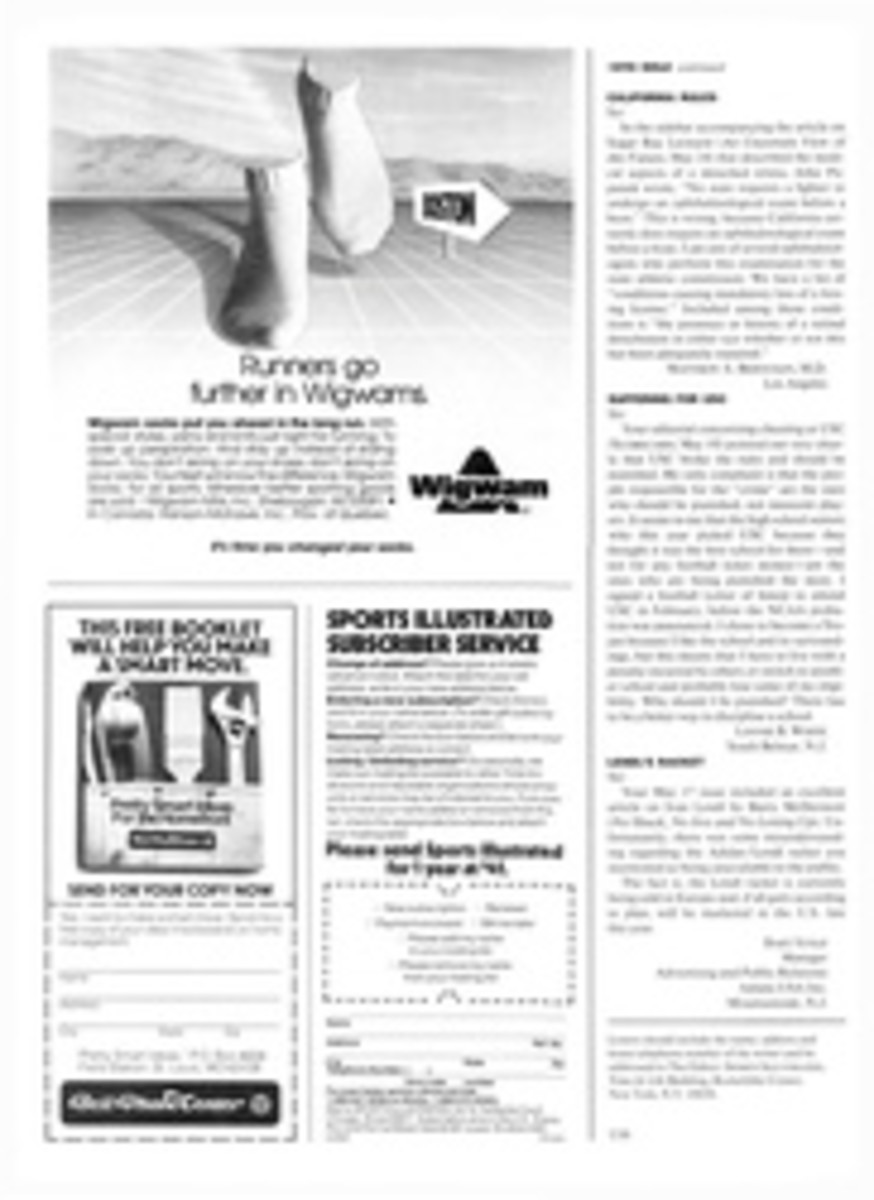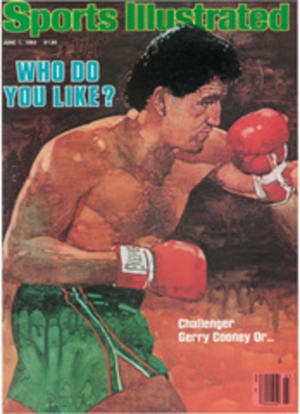
Raymondo had the tempo
Timing is everything with a golfer like Raymond Floyd. He takes the club back with something of a subtle jerk, takes it back rather flat, then he lays it off a little at the top and pushes it down through the ball, his hips and legs doing odd things. It isn't a circus swing, and it may not look all that funny to the non-golfer, but the irregularities in it mean that Floyd's game doesn't travel all that well week to week. When he's on, however, there are few players more skilled all through the bag, and not many pros compete more tenaciously. Last week near Columbus, Ohio, in Jack Nicklaus-land, old Tempo Raymondo, as he's known in the locker room, was definitely on, and he sneaked up on the Memorial Tournament field and did the thing he does about once a year. He won.
Floyd, who is 39, has been winning regularly on the PGA Tour for 20 years—or for nearly as long as Nicklaus has been out there. The Memorial was his 16th victory on the American tour, and the $63,000 first-place check he received put him near the $2 million mark for his career. He's sixth on the alltime money list. Now and then he wins a major, like the 1969 PGA or the 1976 Masters, or a semi-major, such as the 1981 TPC. There are other occasions when you don't even know Floyd is in the field, probably because his timing is off.
For a couple of days last week Floyd wasn't noticed around Nicklaus' Muirfield Village premises, what with most minds being on the weather or Roger Maltbie. But Floyd was hanging around back there in the field as the skies kept darkening and the first three rounds, repeatedly interrupted by rain and forebodings of worse weather, took an eternity to complete.
Floyd was very prominent on Sunday, though. He went out in the last threesome with the co-leaders, Maltbie and Gil Morgan, and, after birdieing the first hole, was tied with them. The three-way struggle continued for the next nine holes, with first one and then another scratching out a short-lived advantage. Then came the pivotal 11th, a meandering par-5 where Floyd saved the tournament he was going to win.
Floyd drove into a bunker and practically topped a three-iron second shot, barely getting it out of the sand. He was still 220 yards from the green and hitting into the wind. "I thought about laying up," he said later, "but then I thought, hell, this is Sunday."
He timed his three-wood lunge perfectly and put his third shot on the green, which allowed him to save par and remain within a shot of the lead. A few minutes there after Floyd birdied the par-4 13th to seize an advantage he would never lose.
At the uphill, upwind par-5 15th he leaned on his three-wood again and reached the greenside bunker in two. A flip out of the sand left him a gimmie birdie that put him at seven under for the tournament; it turned out that seven under—281—would be where he'd finish after rounds of 74, 69, 67 and 71.
There was only one more sticky situation for Floyd. At the par-3 16th, he put his five-iron in the deep fringe behind a bunker, which lay between him and the pin. He had to get up and down to save par. He opened up a sand wedge and hit one of those lob shots that only a veteran knows about. It was a beauty, four feet from the pin. In went the putt. His last two pars were routine. Steady tee shots and irons into the fat part of the greens. Morgan, Maltbie, Wayne Levi and Peter Jacobsen finished tied for second, two shots back.
"I never thought about winning or losing or what number it would take," Tempo Raymondo said afterward. "I was concentrating on each hole, worrying about offense and defense. That's what you have to do at Muirfield. It's the toughest and best-conditioned course we play. If you start thinking about a playoff, you won't be in it. I didn't think about winning until I had a two-shot lead with two holes to play. That's when you ought to be able to handle it."
In Columbus they support the Memorial as if Ohio State were playing football on the velvet valleys of Nicklaus' course. No fewer than 2,400 volunteers were out there seeing that everything ran as perfectly as possible for both the contestants and the fans. The opinion on the PGA Tour is that, overall, this is the best-run tournament on the circuit, and like the Colonial, the tournament Nicklaus won two weeks ago in Fort Worth to break his 21-month dry spell, the Memorial has become a social event as well as a sporting spectacle.
Hence, the throngs keep ignoring the weather each year, and Jack's tournament has become as classy as any of those that rank directly behind the historical Big Four—the U.S. and British Opens, the Masters and our PGA. In importance, the Memorial ("the Ohio Masters") is on the same plateau with the TPC ("the real PGA"), the Crosby ("the Winter Masters") and the World Series of Golf ("the All-Star Game").
The players might put it first on that second plateau. Their judgments tend to be influenced by things like course conditioning, practice facilities, courtesy cars and freebies. From the moment the competitors arrive at Muirfield Village they can't pay for anything at the club. The spacious half-moon practice area is simply the finest in the world. The course is always in immaculate shape, and automobiles are provided for just about everybody who is anybody. There were 75 free cars last week, and every one of them was well used because of the weather.
This has been the year for bad weather on the tour, and the Nicklaus tournament was lucky to be completed, for it had some of the worst weather of all. The Memorial was the 14th tournament out of 22 so far in 1982 in which play was suspended at least once. The third round took some threesomes more than nine hours to finish because of three different interruptions for rain and/or lightning and/or twister alerts.
There are sirens in and around Columbus that alert the residents to tornadoes. Golfers from Columbus—Nicklaus, Ed Sneed and John Cook, for instance—are familiar with the sirens. When they hear them, they know to grab the babies and dive for the cellar. On Saturday, however, Sneed heard the tornado siren more than an hour before he heard the PGA siren suspending play.
"The sky was purple with a little strip of yellow under it when we walked off the 12th," said Sneed. "That's when we heard the tornado siren. I kept an eye out for those little stringy things that fall out of the clouds while we finished the round. Then play was suspended. I was starting to wonder how many of us were going to die in order that CBS could have a telecast."
Until that long, bad Saturday, it had been Maltbie's tournament. Once a colorful tour character because of his nocturnal habits but now a serious married fellow, Maltbie had shot a four-under 68 to lead the first day and had fired a six-under 66 on Friday to break Memorial's 36-hole record and stretch his lead to six strokes over the field.
But on Saturday, Maltbie was forced to start three different times because of the weather, and he finally finished at 8:33 p.m. He shot 75, also thanks to yardage mistakes by his caddie.
Maltbie is the guy who won the very first Memorial in 1976, in a sudden-death playoff with Hale Irwin, when his four-iron second shot to the 17th green hit a stake supporting a gallery rope and bounced onto the green instead of going into the jungle. Maltbie carried that stake around in his golf bag for a while as a good luck charm, but eventually left it under his bed in a motel room. Maltbie is the same fun-lover who celebrated his victory at Pleasant Valley in 1975 for so long that he went off and left the $40,000 first-prize check in a bar. A duplicate check had to be issued. Maltbie dropped from prominence after winning the Memorial, and he has only lately reappeared, largely because of his wife, Donna, who helps him remember what his profession is.
Before Donna came along, Maltbie distinguished himself at the Memorial by setting two other records, both in the 1979 tournament. He shot the highest back nine ever recorded, a 50, and the highest 18, a 92. "I lost that round in a bar, too," he says.
At the start of play last Sunday, it was virtually anybody's Memorial. Fourteen players were within three strokes of each other as Maltbie went out for the final 18 in a tie for the lead with Morgan. Morgan had gained his half of the lead late Saturday afternoon with his own kind of luck with a four-iron. Coming to the last hole trailing Maltbie by two shots, Morgan hit what he called a "smooth four-iron" from, it was said, 167 yards out. The ball landed six inches from the cup and rolled in for an eagle deuce—and a 67.
And then there was Floyd, whose opening 74 had left him six strokes behind Maltbie and whose second-round 69 had only lost ground for him. But his third-round 67 had quietly pulled him to within a stroke of Maltbie and Morgan with 18 to play.
Suddenly, it made sense that Floyd was in contention. Golfers often play well in streaks, and only a week earlier Floyd had tied at Atlanta before losing a one-hole playoff to Keith Fergus, the defender at Memorial. Floyd has said he skips the Memorial every few years because he has never learned how to play the course. This was a good one for him to have been at. His timing was right in more ways than one, it seems.
Though after seven years of the Memorial the winner has yet to break 280 on Nicklaus' course, Jack was shaking his head Sunday evening and saying he wished that just one time the course could play fast. Hard fairways, firm greens, no dampness.
"It was plenty fast for me, Jack," said Tempo Raymondo. "If you ever do get it just the way you want it, none of us will be here."
PHOTO
PHOTO
Three-day leader Maltbie tied for second.

